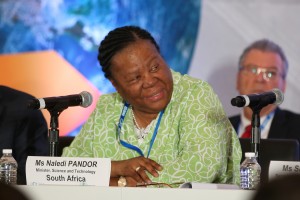 Science and Technology Minister Naledi Pandor officially opened the new Department of Science and Technology (DST) and Council for Scientific and Industrial Research (CSIR) Nanomaterials Industrial Development Facility (NIDF) in December 2015.
Science and Technology Minister Naledi Pandor officially opened the new Department of Science and Technology (DST) and Council for Scientific and Industrial Research (CSIR) Nanomaterials Industrial Development Facility (NIDF) in December 2015.
Delivering the keynote address at the official opening of the NIDF at the CSIR in Pretoria, Pandor described it as an important milestone in fostering innovation.
“The Nanomaterials Industrial Development Facility is an important milestone in a long innovation journey,” Pandor said. “As we look forward to the impact that the facility is likely to have on economic growth, our department will continue to promote public and private sector investment in research and development.
“The NIDF will provide the capabilities for the industrial-scale production of nanostructures and nano-applications required for industrial testing. It provides a unique technology and product development capability for South Africa with respect to nanostructures.
“It is the culmination of a long-term investment in research and development in nanotechnology as an emerging research area.”
Regarding the development of nanotechnology in South Africa, the DST follows the National Nanotechnology Strategy, published in 2005, which Pandor suggested might have to be updated. The strategy sought to use nanotechnology to address issues including energy, health and water provision.
Further, it sought to increase the competitiveness of the country’s strategic industries. These were considered to be advanced materials and manufacturing, chemicals and bio-processing, and mining and minerals.
In 2006, an implementation plan for the National Nanotechnology Strategy was developed and it comprised four elements, which were human capital development, infrastructure, innovation and responsible development. As a result, two nanotechnology innovation centres were established, one each at the CSIR and at the national minerals research organisation Mintek.
The two centres house advanced equipment that universities cannot afford to buy. “These centres have made a significant contribution to nanotechnology in our country and abroad,” Pandor said.
“Established in 2007, the centres have made great progress. We’ve had significant growth of this science of nanotechnology in our country (and) this is largely due to the DST and the science councils.
“If it wasn’t for the DST, we wouldn’t be where we are today. This [investment] has led to the establishment of world-class nanotechnology facilities.”
The DST’s nanoscience and nanotechnology initiatives are the National Nanotechnology Equipment Programme, the Nanotechnology Flagship Programme, and the Nanosciences and Nanotechnology Research Chairs at universities.
One of the results of the nanotechnology equipment programme has been the creation of the Centre for High Resolution Transmission Electron Microscopy, a world-class facility at the Nelson Mandela Metropolitan University. The flagship programme, on the other hand, has so far seen R47-million invested in various projects.
The research chair initiative has resulted in the creation of six Chairs for nanotechnology-related research at six universities. In addition, nanotechnology is one of the sectors benefiting from the R500-million Industry Innovation Partnership, which seeks to incentivise industry to invest in research and development (R&D).
“Established in 2013, it (the Industry Innovation Partnership) was then intended to be a three-year initiative, in the 2013/2016 medium-term expenditure framework period,” Pandor said. “It incentivises industry R&D programmes intended to maintain and expand our export market share.
“South Africa has to expand its export potential enormously. We are importing far too much.”
